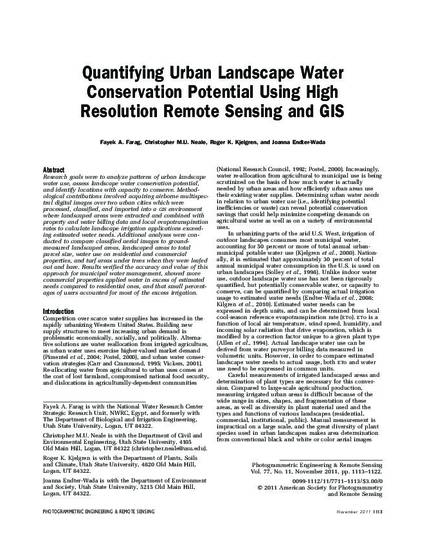
Article
Quantifying Urban Landscape Water Conservation Potential Using High Resolution Remote Sensing and GIS
Photogrammetric Engineering and Remote Sensing
(2011)
Abstract
Research goals were to analyze patterns of urban landscape water use, assess landscape water conservation potential, and identify locations with capacity to conserve. Methodological contributions involved acquiring airborne multispectral digital images over two urban cities which were processed, classified, and imported into a GIS environment where landscaped areas were extracted and combined with property and water billing data and local evapotranspiration rates to calculate landscape irrigation applications exceeding estimated water needs. Additional analyses were conducted to compare classified aerial images to groundmeasured landscaped areas, landscaped areas to total parcel size, water use on residential and commercial properties, and turf areas under trees when they were leafed out and bare. Results verified the accuracy and value of this approach for municipal water management, showed more commercial properties applied water in excess of estimated needs compared to residential ones, and that small percentages of users accounted for most of the excess irrigation.
Keywords
- urban landscape,
- water conservation,
- high resolution remote sensing,
- GIS
Disciplines
Publication Date
January 1, 2011
DOI
https://doi.org/10.14358/PERS.77.11.1113
Publisher Statement
This paper won the following award: 2012 ESRI BEST SCIENTIFIC PAPER IN GEOGRAPHIC INFORMATION SYSTEMS. See: http://www.asprs.org/Press-Releases/ASPRS-ANNOUNCES-2012-AWARD-WINNERS.html
It was published November 2011 in a journal of the American Society for Photogrammetry & Remote Sensing (ASPRS).
Citation Information
Farag, F.A., C.M.U. Neale, R. Kjelgren, and J. Endter-Wada. 2011. Quantifying Urban Landscape Water Conservation Potential Using High Resolution Remote Sensing and GIS. Photogrammetric Engineering and Remote Sensing 77(11):1113-1122.
